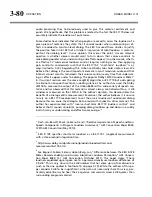
3-82
OPERATION
ORBAN MODEL 1101
lower frequencies, such as movie soundtracks and popular music. It is
therefore desirable to improve on this filter for more general measure-
ment of program loudness.
Discussion and Conclusions
Several studies have shown that the loudness “comfort range” for typical television
listening is +2, –5 dB
. Beyond this range, a viewer is likely to become annoyed,
eventually reaching for the remote control to change volume (or worse from the
broadcaster’s point of view, to mute a commercial). Whether measured via the CBS
or BS.1770 algorithms, the CBS loudness controller algorithm in Orban’s current
products effectively controls subjective loudness to much better than this +2, –5 dB
window.
In the original version of this paper, we had assumed that results using BS.1770 me-
tering would be more consistent if that algorithm employed gating to prevent un-
adorned dialog from reading low compared to music and dialog with substantial
background music or effects. However, this did not prove to be true with the pro-
gram material we used for testing—the results from the BS.1770-1 (ungated) and
BS.1770-2 (gated) measurements were similar when measuring material that had
been processed by the CBS Loudness Controller. It is likely that the loudness-
controlled material seldom caused the gate to act. (The CBS algorithm does not
need silence gating because it is a “short-term” loudness measurement that incorpo-
rates cascaded models of the “instantaneous” and “short-term” loudness time con-
stants of human hearing
, which the BS.1770 algorithm does not.)
Controlling loudness to a standard such as BS.1770 says nothing about the subjective
acceptability of the loudness controller’s action. We have found that a simple loud-
ness controller that uses the inverse of the BS.1770 short-term meter’s output to
control loudness by gain reduction can cause unnatural-sounding gain pumping of
dialog when underscoring and effects appear under the dialog. More complex
automatic loudness controllers can produce all of the well-known artifacts of dy-
namics processing, including noise breathing, spectral inconsistency, gain pumping,
and harshness. Improperly designed multiband compressors can reduce dialog intel-
ligibility
. This is why it is important to carefully assess the audio quality and side
effects that an automatic loudness controller produces so that one can choose a de-
vice that controls loudness effectively without producing objectionable and unnatu-
ral artifacts that can fatigue audiences. Different loudness controllers do not provide
18
ATSC A/85:2009 Annex E, “Loudness Ranges”
19
For example, see Glasberg, B.R. & Moore, B.C.J. (2002) "A Model of Loudness Ap-
plicable to Time-Varying Sounds,” J.AES, vol.50:5, pp.331-342, May 2002.
20
Stone, Michael A.; Moore, Brian C. J.; Füllgrabe, Christian; Hinton, Andrew C.,
”Multichannel Fast-Acting Dynamic Range Compression Hinders Performance by
Young, Normal-Hearing Listeners in a Two-Talker Separation Task,” J. AES Volume
57 Issue 7/8 pp. 532-546; July 2009
Содержание Optimod-PC 1101
Страница 4: ......
Страница 14: ......
Страница 121: ...OPTIMOD PC OPERATION 3 1 Section 3 Operation Figure 3 1 The OPTIMOD PC Control Application...
Страница 192: ...3 72 OPERATION ORBAN MODEL 1101...
Страница 204: ......
Страница 210: ......
Страница 212: ...5 2 UNINSTALLATION ORBAN MODEL 1101...
Страница 236: ......
















































